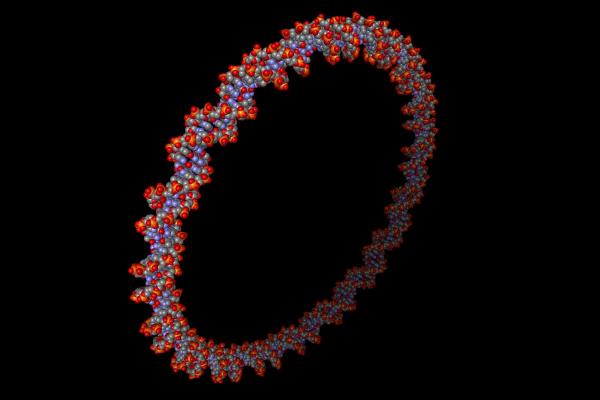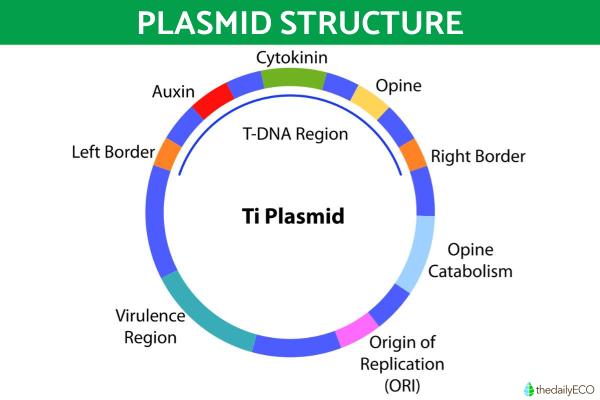
A plasmid is a circular genetic molecule containing DNA that is found within certain cells. It is most commonly found in bacteria, although it has been found in eukaryotic organisms such as certain types of yeast. The main function of plasmids is to act as a vehicle for introducing foreign DNA or genes into bacterial cells. They are separated from chromosomal DNA within the cell because of their role within it. In this thedailyECO article, we explain more about the structure and function of these extrachromosomal DNA molecules by asking what are plasmids and what do they do?
What is a plasmid?
Plasmids are circular DNA molecules found primarily in prokaryotic bacteria, although they can also be found in some eukaryotes such as yeast. These DNA fragments are independent of chromosomal DNA and replicate autonomously, the reason they are types of extrachromosomal DNA.
Plasmids typically contain a limited number of genes, many of which are linked to functions such as antibiotic resistance, which confer evolutionary advantages to the organisms that carry them. While this means they can be necessary in special circumstances, they are separate from chromosomal DNA which contains the genetic information essential for life to be created in the first place.
In biotechnology, plasmids are used as vectors for genetic engineering. Scientists use recombinant DNA techniques to insert genes of interest into plasmids, creating recombinant plasmids that can be introduced into bacteria through processes such as transformation. Basically, they insert foreign DNA into the plasmids as a way to copy DNA fragments because the bacteria can reproduce so quickly[1].
Plasmids can also be transferred between bacteria by conjugation. This is a process which facilitates the dissemination of advantageous genetic characteristics in microbial populations, meaning they can adapt rapidly.
Learn more about DNA molecules with our article explaining the difference between DNA and RNA.

What is the function of plasmids?
Now that we have a definition of what plasmids are and what they can do, we can look into more detail at the specific functions of plasmids. These include the natural functions of plasmids in the cell as well as how they can be manipulated for genetic research:
- They contain genes that produce enzymes capable of making specific changes in the genomes of organisms.
- Many plasmids carry genes that allow the production of fluorescent proteins, such as green fluorescent protein, which are used to track the location and amount of proteins within cells.
- They allow monitoring of chemical levels in different environments, which is important for research in ecology and toxicology.
- Their ability to self-replicate and transfer between bacteria gives them great versatility.
- They act as vehicles for introducing foreign DNA into cells. This function is fundamental to genetic engineering and allows for the manipulation of gene expression in target organisms.
- They facilitate large-scale protein production, allowing researchers to purify and study them under controlled conditions. This capability is essential for the development of therapeutic proteins, such as insulin to be used in diabetes treatment.
- Plasmids are used to create synthetic viruses that have applications in research and therapy. This virus production can aid in the development of treatments for various diseases.
Structure of plasmids
We have already stated that plasmids are circular DNA molecules. Although the overall structure is circular, they are made up of specific parts which work together to carry out its functions. The structure of plasmids contains the following (see diagram below):
- Origin of replication (ORI): this DNA sequence is crucial for the initiation of plasmid replication. It allows the cellular machinery to recognize the plasmid and begin the replication process independently of the host's chromosomal DNA.
- Antibiotic resistance gene: this gene allows for the selection of bacteria containing the plasmid. When the plasmid is introduced into a medium containing antibiotics, only transformed cells survive. This makes it easier to identify those that have acquired the plasmid.
- Multiple cloning site (MCS): the MCS is a DNA segment containing several restriction sites. This allows for the easy insertion of foreign DNA, essential for the creation of recombinant plasmids.
- Promoter region: this region is essential for the transcription of the target gene. The effectiveness of gene expression depends on this region, determining the cell types in which the gene is expressed and the amount of protein produced.
- Selectable marker: in addition to the antibiotic resistance gene, some plasmids include this type of marker that facilitates selection in different cell types.
- Primer binding site: this is a short DNA sequence used as a starting point for PCR amplification or sequencing, allowing verification of plasmid sequences.
As we have stated, plasmids are usually found in prokaryotic cells. Learn more about the nature of prokaryotes with our article asking what is a nucleoid?

Why are plasmids important?
Now we know the structure and function of plasmids, we learn the reason why plasmids are so important in biological science:
- Their ability to insert genes of interest through various cloning methods (such as restriction enzymes and ligation techniques) makes them essential in genetic manipulation.
- Once a gene is inserted into a plasmid, it is transformed into bacterial cells and selectively cultured on plates with antibiotics. This process allows scientists to produce large quantities of plasmids, facilitating their use in subsequent experiments.
- Plasmids are primarily used to manipulate gene expression in target cells. Their flexibility, versatility, safety and cost-effectiveness allow for their application in diverse research areas.
- There are several types of plasmids, including cloning plasmids, expression plasmids, gene silencing plasmids and viral plasmids. Each type has specific applications, such as the production of large quantities of proteins, chemical monitoring and the genetic modification of organisms.
- Over the past decade, plasmid DNA has been investigated as a promising platform for the development of DNA vaccines. These vaccines can offer significant advantages, such as eliminating infectious agents and stimulating immune responses.
Hopefully you can know see the importance of plasmids due to their great ability to reproduce in certain cells. You can learn more about cell reproduction with our article asking what is binary fission in biology?
If you want to read similar articles to What Are Plasmids and What Do They Do?, we recommend you visit our Biology category.
1. Hussey C. (1992). Recombinant plasmids. Safety in Industrial Microbiology and Biotechnology, 93–152. https://doi.org/10.1016/B978-0-7506-1105-3.50010-1
- Monroe, M. (2020). Plasmids 101: What is a plasmid?
https://blog.addgene.org/plasmids-101-what-is-a-plasmid - CD Genomics Blog. (2019). Plasmid Fact Sheet: Definition, Structure and Application.
https://www.cd-genomics.com/blog/plasmid-fact-sheet-definition-structure-and-application/ - National Human Genome Research Institute. (2025). Plasmid.
https://www.genome.gov/genetics-glossary/Plasmid - Schmerker, J. (2023). What is a plasmid and what do plasmids do?
https://www.idtdna.com/pages/community/blog/post/what-is-a-plasmid-and-what-do-plasmids-do